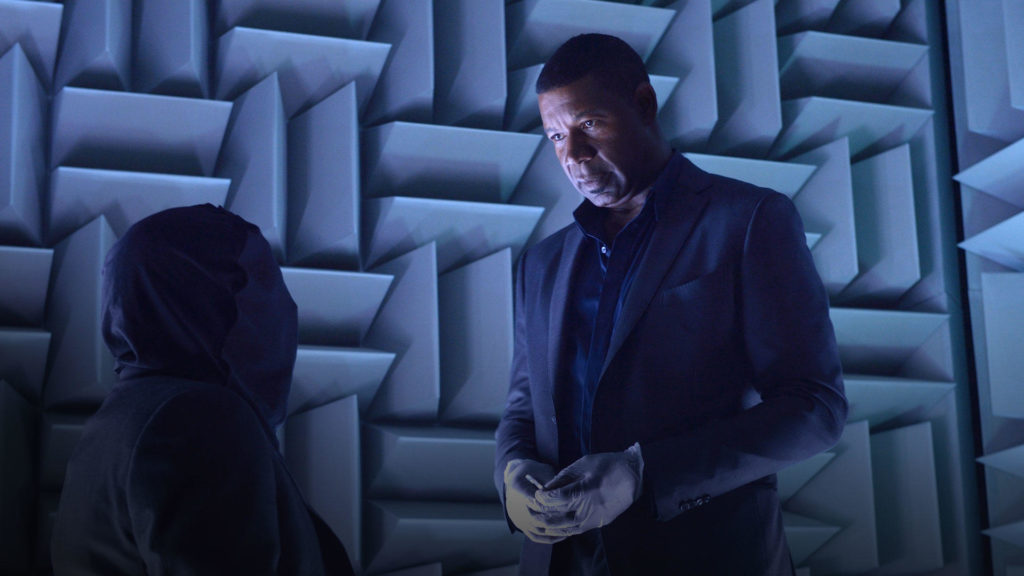The Syfy show Incorporated is a thriller set in the year 2074, where corporations have unlimited power. The series follows a young executive named Ben Larson (played by Sean Teale), who must infiltrate this dangerous world by climbing the corporate ladder to save the love of his life. In doing so, he must compromise his position on the entire corporate system.

The show premiered last fall, and its early promotion included a pop-up VR experience developed by Digital Domain that was shown at the San Diego Comic Con. Aruna Inversin, the creative director and visual effects supervisor of virtual/augmented reality at Digital Domain, spoke about the technical details of the Incorporated VR experience, called Welcome to the Quiet Room, at the Game Developers Conference. Inversin also sat down with [a]listdaily at the conference to discuss how Syfy wanted to create a memorable activation that would leave people wanting more.
Welcome to the Quiet Room involves a soundproofed room where the corporation test recording equipment along with its interrogation techniques. Dennis Haysbert, who plays Julian Morse on the show, interrogates the user (who is tied to a chair) with various torture devices. In the real-life activation, users were asked to keep their hands behind their backs, leaving them free to look around, but limiting their movement.
“The project takes place in a room and in real-time using the HTC Vive and we shot it with plate photography,” said Inversin, explaining how the VR experience was made. “We went on location and shot Dennis Haysbert live on a green screen stage and then used our internal system to make a narrative in the real-time space. You’re actually watching the performance, but you have the position of ability to move your head. I don’t think anybody has done it to the extent that we have yet—putting in moving plate photography into a real-time environment. Most of the time, I think it has been about capturing a 360 video and putting it in a sphere. This is a more game-centric approach toward building a narrative.”
Inversin said that fans were ecstatic about the experience. “We were able to make magic and pull the wool over people’s eyes, in a sense,” he said. “It was a defining project in the sense that not a lot of people have been able to overcome using live-action photography, and we did this on a small budget and time frame. I think people liked it, but I wish more people had been able to see it.
According to Inversin, the activation was held at a Hard Rock Café, where Syfy set up a booth near the convention. As a result, there wasn’t as much foot traffic as they would have gotten if they had a show floor presence. However, there was significant word-of-mouth promotion, which kept the lines going down the block.
A consumer-facing experience, in the form of a downloadable game on Steam, was discussed but never went forward because of costs. But Inversin is fine with that, stating: “It was always meant to be an activation that people went to in order to experience it.” However, Digital Domain did make a 360-degree video version of the experience for YouTube and Facebook when the series premiered. Unlike the VR activation, people can see the experience but can’t interact by moving their heads around.
When asked why Syfy decided on a pop-up activation instead of appealing to the largest group from the start with a video, Inversin explained that “often, when we have clients come in and they talk about what they want in a VR experience, they usually go to their staples, like a 360 video to put on YouTube. We’ve done that in the past, but it’s not pushing the envelope of VR forward.”
He continued by stating that, “the future of VR isn’t necessarily with monoscopic video, even though I think there might be a need for it for broadcasts and livestreams. In terms of the interactive narrative and storytelling, you’ll get a much more impactful presence on the consumer marketplace with positional tracking. Even the ability to move your head just an inch gives you that nuance like you’re there.”
Inversin also stated that Syfy had partnered with HTC to develop the experience for the Vive, so it didn’t make much sense to settle for a 360 video. “We wanted to cater to the hardcore people who understood the technology,” he said.
We asked Inversin about the relationship between VR and actual reality, since the activation included a real-life recreation of the quiet room, and participants make an agreement with the presenter to keep their hands behind their backs. He said that being in a real-life space “helps to get your mind used to those textures in real life. We did a pretty good mimicry of that room, so when you put on the headset it still looks like you’re in the same place. We worked regularly with the set crew and we built our room based on their dimensions and used the same textures for the soundproofed walls. So, I think it makes a big impact and it gets you prepped for the experience.”
In discussing whether a home experience might have had the same impact, Inversin said: “I don’t think so. One of the reasons why is because, at a pop-up activation like that, you have control over the viewing environment. With VR, you have no control over what the user does and sees. So, if we were to release it as a kind of stand-alone experience, you would be able to see the gags of how we did it right away.
The user would be able to get up, walk around, and see the magic behind the trick, which is what we were trying to prevent. In the experience, in addition to having users keep their hands behind their backs, we had a ‘safe zone.’ If the user got out of that safe zone to peek around, we made some post-processing effects to make it nauseating. Your vision gets wavy, as if you were drugged, which helps steer the person back into the safe zone of seeing everything clearly. That’s part of the experience too, because you’ve been drugged when Dennis Haysbert interrogates you.”
With television shows such as Westworld and movies such as John Wick 2, we’re seeing an increased use of VR as a part of their promotion. We asked Inversin for his thoughts about Hollywood’s increased use of VR.
“I think VR gives the user a chance to experience a world that you can’t do with a traditional film,” said Inversin. The mythology and richness of some of these movies makes you want to see another one, or get inside the character’s head to see how that world ticks. Something like that can only be done in VR, where the users create their own narrative.
John Wick and Westworld put you into these worlds that are engaging and let the users define that. It’s another step forward into tying VR into the traditional film and television schedule. There is a marketing push that will keep engagement going in between films, like with the game Star Wars Battlefront. People are engaging with that world while the movies are still in production. But the caveat is that if it’s all game-based graphics, then it’s not as photorealistic like the film. With Incorporated, we were trying to create a live-action VR experience that’s a narrative but isn’t part of the show.”
Since the line that separates a VR promotion from a video game is becoming increasingly blurred (or in the case of John Wick, non-existent), we asked Inversin if he thought increased interactivity would be part of future promotions—beyond users moving their heads around.
“With every increase in interactivity, you have to have a failsafe,” Inversin said. “What if they don’t follow your rules? What if they decide to jump out a window or go in a different direction? A lot of traditional directors want to do a narrative that’s directable but not necessarily interactive. They like the VR immersion but they want people to follow their vision.” The resulting compromise is a 360-degree video.
“There also needs to be a specific beginning and end to the experience with a specific time spent with it,” Inversin continued. “A lot of these activations need to get people in and out. But as consumers become more knowledgeable, they’ll want to do more, like move their heads around. So, I think that’s the next big step—positional narrative. That hasn’t really been done before except with games.”

